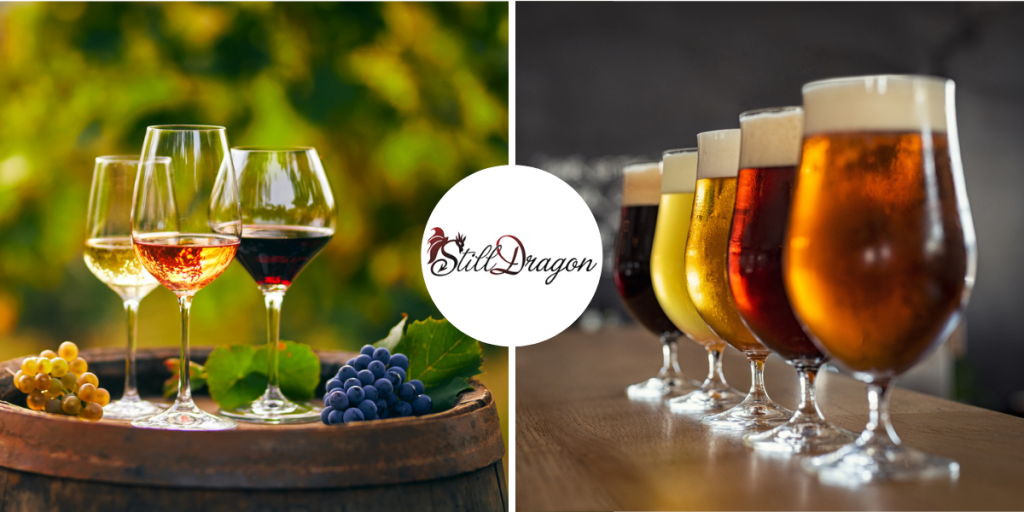Beer vs Wine in Distilling: What is the Difference?

Beer and wine are both universally familiar words to the average consumer. For some people, the word beer brings and instant, familiar mental image of some popular brand, or favorite kind of food? The “king of beers” with a slice of pizza for example? Or maybe a nice red wine paired with a savory goose liver pate appetizer? Yum!
Getting into a bit more detail, you may understand that beers are typically made with a grain starch source such as malted barley and wines are made with fruit.
If we go further into our understanding of beer and wine, we learn that beers can be made with multiple types of grains and wines can be made with any kind of fruit. Typically, wine made with grapes contain more alcohol than beer on a by the volume basis, or ABV. With wine, the fruit juice is ready for fermentation immediately as the sugars are readily accessible after pressing to rupture the fruit cells. For beer on the other hand, the grains must first be cooked to render the starches out of the grain, and then the starches must be converted to sugars by an enzyme called amylase and then further broken down into simple sugars by other enzymes. The process of making beer can be far more laborious compared to making wine. Especially considering that alcoholic yield is higher with wine. Having said that, not all fruit contains the same amount of sugar and not all grains contain the same amount of starches. A successful crop for alcohol production is not only determined by potential volumetric / weight yield of the actual crop, but also by alcohol by volume of yield after fermentation. In other words, 100 pounds of grapes makes more proof gallons of alcohol than 100 pounds of barley. And so, there is that. Let’s move on.
The familiar beer or wine word becomes more nebulous or confusing to the lay person when referenced within the context of distillation. In distilling, a distiller’s beer is simply a fermented, low abv mixture that is made from fermented grains. Distilled beer makes whiskey. Therefore, whiskies are made from grains. However, a distiller’s beer very often is not really intended to be consumed as a beer like one would find at the local super market. The main goal of the distiller’s beer is to produce an amount of alcohol without much regard for drinkability. Then distill and allow some of the grain flavors to carry over into the finished distillate based on any number of distillation techniques.
As with a distiller’s beer, wine for brandy production does not have to be a premium beverage wine in order to make a palatable brandy. Again, the goal with a distiller’s wine is to produce ethanol from fermented fruit and utilize specific distillation techniques to allow some of the fruit character to carry over into the finished distillate.
Now let’s move on to the really confusing part that really is more about nomenclature used in the distilling world. Ok, get this, in distilling there is a thing called high wines and low wines. Neither of which is an actual grocery store variety of wine. And neither has to necessarily be made from actual fermented wine.
Each is an actual distillate. Let me explain. As a general rule, low wines are the distillate collected from a stripping run. In other words, a first distillation used to reduce the amount of water in the beer or wine kettle charge. There can be some confusion on this term as there is no set standard with respect to ABV of low wines. But generally low wines are about 25 – 35% alcohol by volume. The term high wines describes distillate that has a high percentage of alcohol, but not necessarily the finished spirit. Generally anything above 35% alcohol by volume. So, for example, a spirit distilled through a pot still 3 times would start with a beer charge in the kettle. The resulting distillate could be considered low wines. On the second run the kettle would be charged with low wines. The resulting distillate could be considered high wines. And for the final spirit run, the kettle is therefore charged with high wines and the resulting distillate would be considered the finished spirit. Typically, the distiller would run each batch according to the desired, aggregate abv of the next forthcoming distillation. And it is entirely up to the distiller if he/she chooses to make any kind of cut during a stripping or second run. Some distillers make small heads cut on the stripping run. Others choose not to. There are no hard and fast rules for making cuts.
Ok so that’s it for now. I hope I have been able to articulate the beer / wine difference at the grocery store vs the beer / wine appellation used around the distillery?
Give us ring here at StillDragon if you have any questions. Call 561-845-8009 or check us out at StillDragon.com. You can also check out the global forum (stilldragon.org) where StillDragon customers and other distilling enthusiasts go to talk about all things distilling.